
Little Annie Rooney is a comic strip about a young orphaned girl who traveled about with her dog, Zero.

Tim Tyler's Luck is an adventure comic strip created by Lyman Young, elder brother of Blondie creator Chic Young. Distributed by King Features Syndicate, the strip ran from August 13, 1928, until August 24, 1996.

Lance was an American comic strip notable as the last of the full-page strips. Created and self-syndicated by artist Warren Tufts, it ran from June 5, 1955, to May 29, 1960.

Mickey Finn was an American comic strip created by cartoonist Lank Leonard, which was syndicated to newspapers from April 6, 1936 to September 10, 1977. The successful lighthearted strip struck a balance between comedy and drama. It was adapted to a 400-page Little Big Book and was reprinted in several comic book series throughout the 1930s and 1940s.

Reg'lar Fellers is a long-running newspaper comic strip adapted into a feature film, a radio series on the NBC Red Network, and two animated cartoons. Created by Gene Byrnes (1889–1974), the comic strip offered a humorous look at a gang of suburban children. Syndicated from 1917 to January 18, 1949, Byrnes' strip was collected into several books. Branding also extended to such items as baseball bats and breakfast cereal.
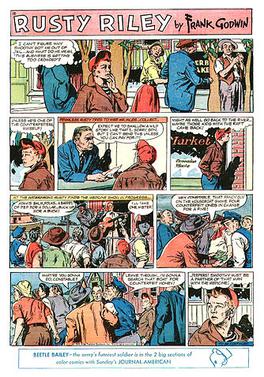
Rusty Riley is an American adventure comic strip which ran from 1948 to 1959. It was created and drawn by Frank Godwin for King Features.
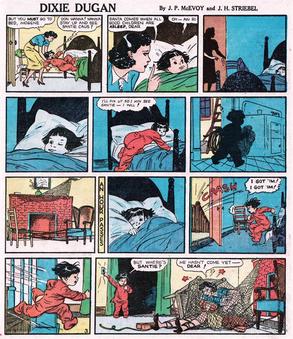
Dixie Dugan is best known as a long-running syndicated newspaper comic strip published from October 21, 1929 to October 8, 1966. The title character was originally modeled after 1920s film actress Louise Brooks and early stories followed Dixie's exploits as a Hollywood showgirl.

Bronc Peeler was a Western adventure cowboy comic strip created by Fred Harman in 1933, and ran until July 2, 1938. Harman is best known as the artist for the Red Ryder comic strip, which he created with Stephen Slesinger.

The Bungle Family is an American gag-a-day comic strip, created by Harry J. Tuthill, that first appeared in 1918. Originally titled Home, Sweet Home, it first appeared as part of a series of rotating strips in the New York Evening Mail. The strip ran until June 2, 1945.
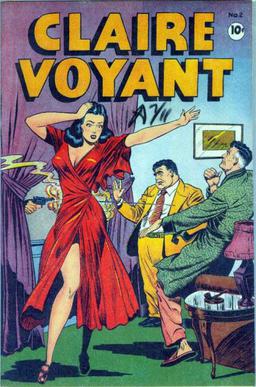
Claire Voyant is an American syndicated comic strip created by cartoonist Jack Sparling. The strip premiered on May 10, 1943, in the New York newspaper PM, and continued until November 23, 1948. Her name is a pun on clairvoyance.

Ella Cinders is an American syndicated comic strip created by writer Bill Conselman and artist Charles Plumb. Distributed for most of its run by United Feature Syndicate, the daily version was launched June 1, 1925, and a Sunday page followed two years later. It was discontinued on December 2, 1961. Chris Crusty ran above Ella Cinders as a topper strip from July 5, 1931 to July 6, 1941.
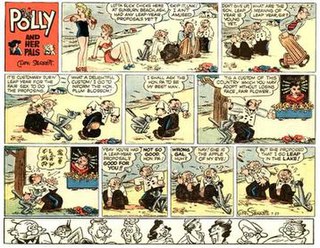
Polly and Her Pals is an American comic strip, created by cartoonist Cliff Sterrett, which ran from December 4, 1912, until December 7, 1958. It is regarded as one of the most graphically innovative strips of the 20th century. It debuted as Positive Polly on December 4, 1912, in William Randolph Hearst's newspapers, initially the New York Journal, and was later distributed by King Features Syndicate. The title changed to Polly and Her Pals on January 17, 1913.

Agatha Crumm is a newspaper comic strip created by the cartoonist Bill Hoest and distributed by King Features Syndicate. The strip ran from October 24, 1977, until 1997. Agatha Crumm was Hoest's third strip, following Bumper Snickers (1974).

Barney Baxter in the Air is an American comic strip by Frank Miller. It started its run on September 30, 1935, for the Denver's Rocky Mountain News. Starting on December 7, 1936, it was syndicated by King Features. Barney Baxter was an "adventure strip" involving heroic exploits centering on aviation.
Baron Bean is a newspaper comic strip created by the cartoonist George Herriman. Baron Bean was distributed by King Features Syndicate.
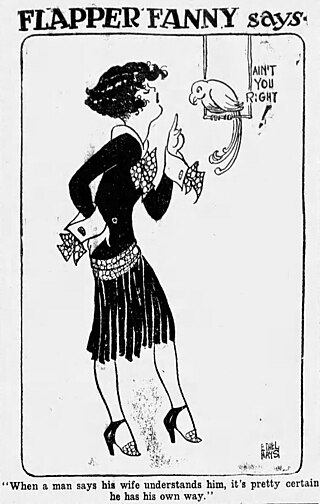
Flapper Fanny Says was a single-panel daily cartoon series starting on January 26, 1925, with a Sunday page following on August 7, 1932. Created by Ethel Hays, each episode featured a flapper illustration and a witticism. The Sunday strip concluded on December 8, 1935; the daily panel continued until June 29, 1940.
Morty Meekle is an American syndicated newspaper comic strip that was published between 1956 and 1966, created and produced by cartoonist Dick Cavalli. The series featured the title character dealing with office and dating situations, and, like Fritzi Ritz, which became Nancy after sixteen years, evolved to focus on the younger characters from Cavalli's strip, and was renamed Morty Meekle and Winthrop and then just Winthrop on February 27, 1966.
Silly Symphony, initially titled Silly Symphonies, was a weekly Disney comic strip that debuted on January 10, 1932, as a topper for the Mickey Mouse strip's Sunday page. The strip featured adaptations of Walt Disney's popular short film series, Silly Symphony, which released 75 cartoons from 1929 to 1939, as well as other cartoons and animated films. The comic strip outlived its parent series by six years, ending on October 7, 1945.
Uncle Remus and His Tales of Br'er Rabbit is an American Disney comic strip that ran on Sundays from October 14, 1945, to December 31, 1972. It first appeared as a topper strip for the Mickey Mouse Sunday page, but after the first few years, almost always appeared on its own. The strip replaced the 1932-1945 Silly Symphony strip, which had spent its final year on gag strips featuring Panchito from The Three Caballeros.
Jim Hardy is a 1936-1942 American adventure comic strip written and drawn by Dick Moores and distributed by United Features Syndicate. It was Moores' first solo comic strip work, before he gained renown for his work on Gasoline Alley. The strip told the story of Jim Hardy, a down-on-his-luck "man against the world".
















